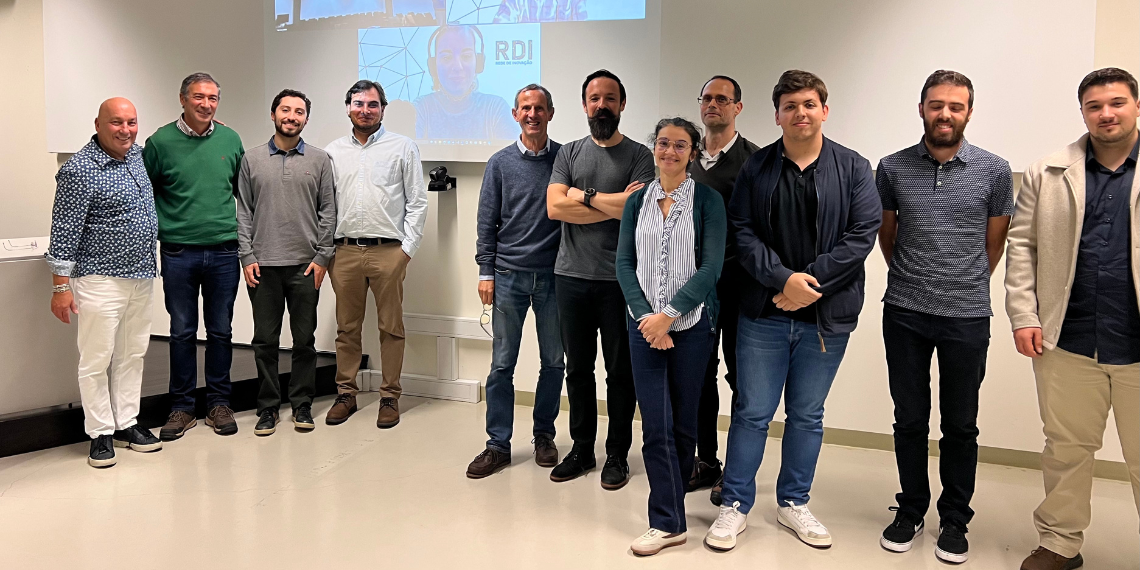INESC TEC participated in the kick-off meeting of the DFENCE project – which aims to develop a system integrating prediction, planning, soil analysis and autonomous animal guidance. The main objectives of the event were to define the technical orientation between consortium members and plan the first activities.
The application of technology and innovation across different sectors of society is undeniable – and livestock farming is no exception. Precision livestock farming, for example, relies on sensors and new technologies to improve the management of large animal groups, namely through virtual fencing (VF). This technology enables the remote monitoring of animals through an electronic device placed on the animal, typically attached to a collar – which then sends notifications to the owners whenever the animals cross predefined limits. By allowing a more efficient management of grazing areas, the VFs still force the producers to check on the animals that leave the predefined limits.
But what if it were possible to go further? That is the goal of the new DFENCE project – Dynamic Virtual Fences: Remote Control and Monitoring of Free-Range Grazing through a Non-Intrusive Animal Guidance System, featuring INESC TEC as a partner. The project seeks to evolve these systems from reactive to proactive ones, acting at the level of planning animal movement and adopting a holistic view of the problem. In other words, it does not merely react to the animals’ movements; it aims to influence them over time, optimising both soil and pasture quality, as well as animal welfare and health.
Alongside the technical challenges inherent to a project of this nature, one of the central elements is training animals to address to audio and/or vibratory stimuli emitted by the collar – a process whose complexity depends on factors like species and age.
According to Davide Carneiro, “this type of project demands significant interdisciplinarity, which is only possible thanks to the composition of the consortium: Linovt, responsible for developing the device; the Polytechnic Institute of Viana do Castelo, responsible for animal training and behaviour; and INESC TEC, which ensures all the data-related components.”
The researcher also highlighted INESC TEC’s role in the project: “our contribution focuses on integrating multiple data elements – ground sensors, satellite imagery, collar data and environmental information – and on the combined use of Artificial Intelligence (AI), optimisation and simulation techniques to support decisions that promote efficient soil use and animal welfare.”
Several elements differentiate the solution developed under the DFENCE project from others. For example, the dynamic and autonomous definition of virtual fences – based on prediction algorithms, computer vision and environmental data analysis. Another aspect is full integration with IoT sensors, collecting data on soil, vegetation, climate and the animals themselves. Non-intrusive guidance, using sound and vibratory stimuli, as well as the intelligent decision-support system capable of predicting future pasture needs and optimising land use, are also specific features of DFENCE. Finally, the explicit focus on sustainability, soils and ecosystems is something not found in existing commercial solutions.
According to Davide Rua Carneiro, there are “scattered advances” in the literature and industry regarding VF technologies: “GPS-based monitoring, behaviour detection using accelerometers, the use of Artificial Intelligence (AI) to identify grazing patterns, or vegetation assessment using satellite and drone imagery.” However, he stressed that these systems are mostly passive monitoring tools, “not integrating prediction, planning, soil analysis and automatic animal guidance into a single system.”
Hence, it seems clear that DFENCE advances the state of the art – introducing several innovations. These include the use of deep learning to characterise pasture conditions, such as the Normalised Difference Vegetation Index (NDVI), vegetation density and bare soil; computer vision for pasture-quality mapping and anomaly detection; predictive and planning models enabling automatic optimisation of grazing areas; and multisource data integration from satellites, drones, rovers, IoT sensors and collars.
Meeting several farmer needs, the project is expected to generate impact across multiple areas.
From an agro-environmental perspective, it is expected to lead to “reduced carbon emissions (notably by minimising travel by farmers to remote locations for monitoring or animal correction), improved soil quality and biodiversity, and mitigation of erosion and overgrazing through optimised management.” Economically, the project may enable “more efficient resource use, reduced costs associated with physical fencing and labour, and the creation of new exportable technological products and services with strong international potential.” In terms of animal welfare, results may include “less intrusive guidance, reduced use of invasive stimuli, and continuous monitoring of health and behaviour.” When it comes to operation, “greater farmer autonomy, data-driven decision-making and automatic pasture optimisation” are anticipated.
As a project partner, INESC TEC will be responsible for the AI and planning components, “including computer vision with satellite imagery for the characterisation of soil conditions, forecasting their evolution, and planning herd movement in order to optimise pasture use and animal welfare and health,” stated Davide Rua Carneiro. Machine learning and deep learning algorithms will be applied to identify optimal grazing zones and dynamically adjust virtual boundaries, complementing simulation and optimisation techniques.
The DFENCE project is coordinated by Linovt and involves the Polytechnic Institute of Viana do Castelo, alongside INESC TEC. It has an expected duration of three years.
The researcher mentioned in this news piece is associated with INESC TEC and IPP-ESTG



 News, current topics, curiosities and so much more about INESC TEC and its community!
News, current topics, curiosities and so much more about INESC TEC and its community!